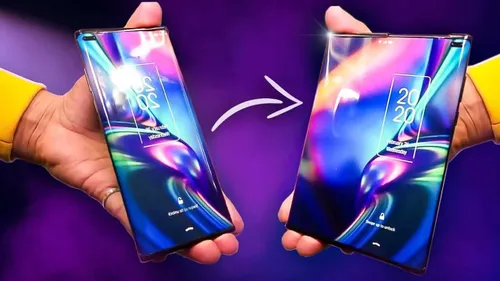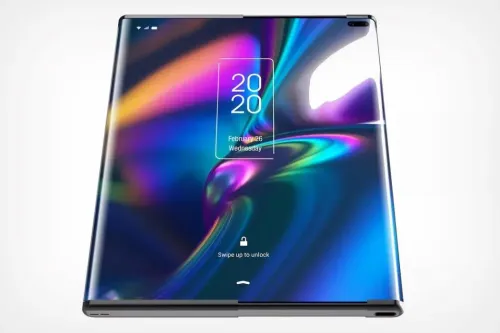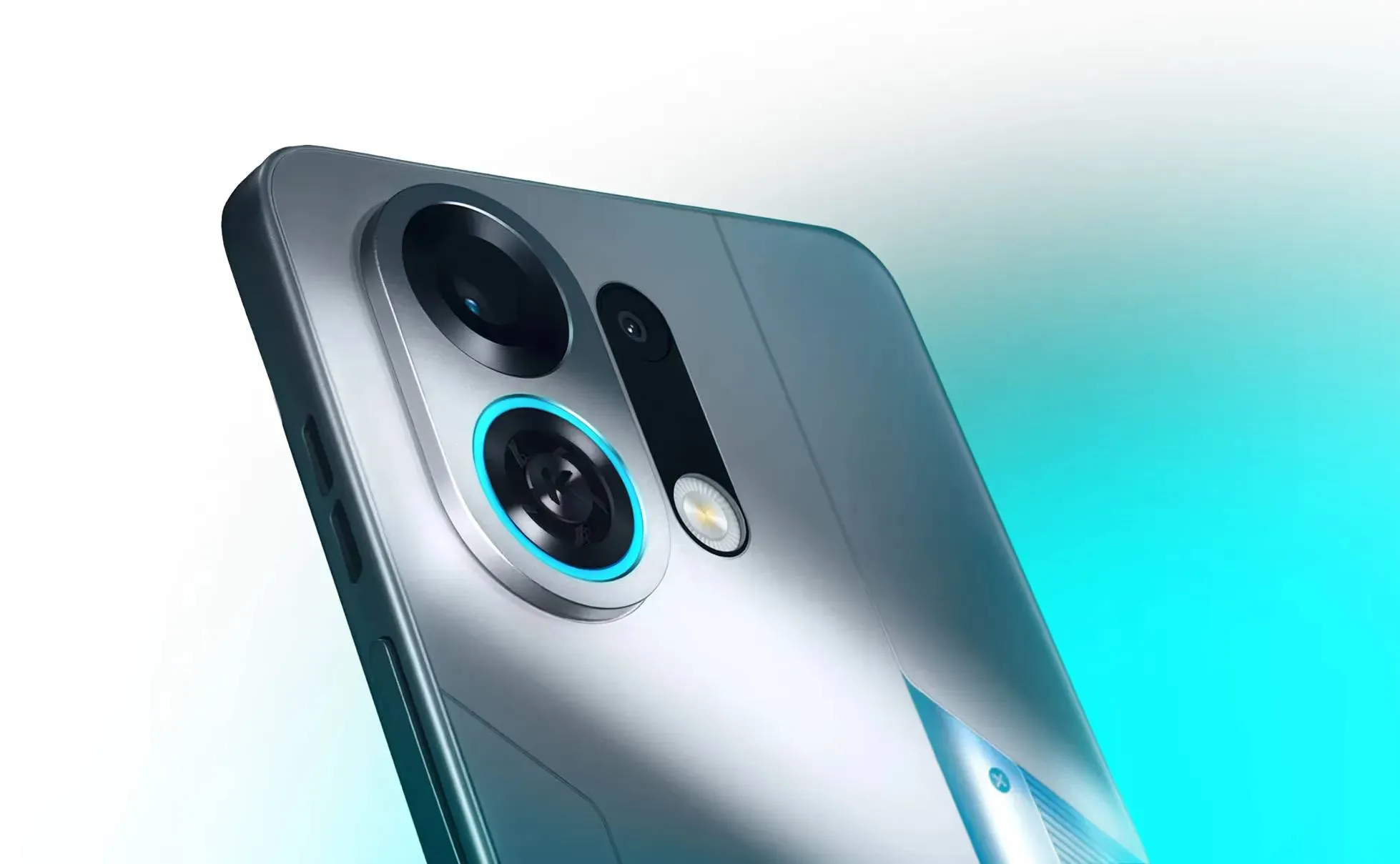Scrollable Screen Smartphones Coming Soon from Samsung and Apple
SamsungFriday, 25 August 2023 at 08:20

Samsung and Apple are reportedly both planning to launch scrollable screen smartphones in 2025. The devices are said to use flexible displays that can be rolled out to increase the screen size.
Samsung and Apple Eye 2025 Launches for Scrollable Screen Smartphones

Samsung has been developing scrollable screen technology for several years, and it has already shown off prototypes of the technology. The company is reportedly planning to start mass production of the devices in 2025.
Apple is also said to be interested in scrollable screen technology. The company has filed patents for scrollable screen devices, and it is rumored to be working on a prototype of the technology.
It is not yet clear what the scrollable screen smartphones from Samsung and Apple will look like or what features they will have. However, the devices will be a major innovation in the smartphone market.
Scrollable screen smartphones could offer a number of advantages over traditional smartphones. They could have larger screens for watching videos or playing games. They could also be more compact when folded up, making them easier to carry around.
In addition to the larger screen and more compact design, scrollable screen smartphones could also offer a number of other advantages. For example, they could be in use to create more immersive experiences, such as virtual reality or augmented reality. They could also be in use to improve productivity, by allowing users to view multiple windows at once.
However, there are also some challenges that need to be addressed before scrollable screen smartphones can become mainstream. One challenge is the durability of the flexible displays. The displays need to be able to withstand being rolled up and unrolled repeatedly without breaking.
Another challenge is the cost of the technology. Scrollable screen smartphones are likely to be more expensive than traditional smartphones.
Despite the challenges, scrollable screen smartphones have the potential to be a major trend in the smartphone market. The technology is still in development, but it could revolutionize the way we use smartphones.
In addition to the technical challenges, there are also some potential marketing challenges that Samsung and Apple will need to address. For example, they will need to convince consumers that scrollable screen smartphones are a worthwhile investment. They will also need to educate consumers about the benefits of the technology.
Overall, the launch of scrollable screen smartphones in 2025 could be a major turning point for the smartphone market. The technology has the potential to revolutionize the way we use smartphones, and it could give Samsung and Apple a significant advantage over their competitors.
The potential benefits and challenges of scrollable screen smartphones:
Benefits:
- Larger screens for watching videos, playing games, and browsing the web.
- More compact design when folded up.
- Easier to carry around.
- More versatile functionality, as the screen can be resized to fit different tasks.
- Improved productivity, by allowing users to view multiple windows at once.
- Immersive experiences, such as virtual reality and augmented reality.
Challenges:
- High cost.
- Durability issues.
- Consumer education.
- Competition from other emerging technologies, such as foldable smartphones.
Despite the challenges, scrollable screen smartphones have the potential to be a major trend in the smartphone market. The technology is still in development, but it could revolutionize the way we use smartphones.

Scrollable screen smartphones industry
- Market potential: The market for scrollable screen smartphones is expected to grow rapidly in the coming years. According to a report by IDC, the market for foldable and rollable smartphones is expected to reach 100 million units by 2027. This growth is being driven by the increasing demand for larger and more versatile smartphones.
- Technological challenges: The main technological challenges that need to be addressed before scrollable screen smartphones can become mainstream are the durability of the flexible displays and the cost of the technology. Flexible displays are still relatively new, and they need to be able to withstand being rolled up and unrolled repeatedly without breaking. The cost of flexible displays is also a challenge, as they are currently more expensive than traditional displays.
- User experience: The user experience of scrollable screen smartphones is also a challenge that needs to be addressed. Developers will need to create new user interfaces that are optimized for scrollable screens. This will require a lot of experimentation and testing.
- Competitive landscape: The competitive landscape for scrollable screen smartphones is still developing. Samsung and Apple are the two leading manufacturers of smartphones, and they will noth launch scrollable screen devices in 2025. However, there are also a number of smaller manufacturers that are working on scrollable screen smartphones.
Overall, the market for scrollable screen smartphones is expected to grow rapidly in the coming years. However, there are still a number of challenges that need to be addressed before the technology can become mainstream.
Here are some additional thoughts on the subject:
- Scrollable screen smartphones could be a game-changer for the smartphone market. They could offer a number of advantages over traditional smartphones, such as larger screens, more compact designs, and improved productivity.
- However, there are also some challenges that need to be addressed before scrollable screen smartphones can become mainstream. These challenges include the durability of the flexible displays, the cost of the technology, and the user experience.
- Despite the challenges, I believe that scrollable screen smartphones have the potential to be a major trend in the smartphone market. The technology is still in development, but it has the potential to revolutionize the way we use smartphones.
I am excited to see how the development of scrollable screen smartphones progresses in the coming years. I believe that this technology has the potential to make a significant impact on the smartphone market.
How scrollable screen technology will affect the smartphone market:
- Increased demand for larger screens: Scrollable screen smartphones offer the ability to have a larger screen without the bulkiness of a traditional tablet. This could lead to increased demand for larger screens in smartphones, as consumers look for devices that can be in use for both productivity and entertainment.
- New possibilities for gaming and video viewing: Scrollable screen smartphones could open up new possibilities for gaming and video viewing. For example, gamers could have a larger screen to play on, while video viewers could watch movies or TV shows in a more immersive way.
- Improved productivity: Scrollable screen smartphones could also improve productivity. For example, users could have multiple windows open at once, which could be helpful for multitasking.
- New form factors: Scrollable screen technology could also lead to new form factors for smartphones. For example, devices could arrive with a scrollable screen that can be in use in portrait or landscape mode.
- Competition with other technologies: Scrollable screen technology will also face competition from other technologies, such as foldable smartphones and augmented reality. These technologies offer their own advantages and disadvantages, and it remains to see which technology will ultimately be more popular.
Overall, scrollable screen technology has the potential to disrupt the smartphone market. It offers a number of advantages over traditional smartphones, and it could appeal to a wide range of users. However, there are also some challenges that cpmanies need to address before the technology can become mainstream.
Here are some specific examples of how scrollable screen technology could improve the user experience:
- Reading: Scrollable screen smartphones could make it easier to read long articles or books. Users could simply scroll the screen to view more text, without having to zoom in or out.
- Web browsing: Scrollable screen smartphones could make it easier to browse the web. Users could have multiple tabs open at once, and they could easily scroll between them.
- Gaming: Scrollable screen smartphones could make gaming more immersive. Users could have a larger screen to play on, and they could also use the screen to interact with the game.
- Video calling: Scrollable screen smartphones could make video calling more natural. Users could have a larger screen to see their conversation partner, and they could also use the screen to gesture or draw.
These are just a few examples of how scrollable screen technology could be in use to improve the user experience. As the technology continues to develop, we can expect to see even more innovative ways to use it.

My own vision on the future of mobile computing in light of this
I see the future of mobile computing as being increasingly diverse and innovative. Scrollable screen technology is just one of the many new technologies that are emerging, and it has the potential to revolutionize the way we use our phones.
In addition to scrollable screen technology, other emerging technologies that could have a major impact on mobile computing include:
- Foldable smartphones: Foldable smartphones offer the ability to have a large screen in a compact form factor. This could make them more appealing to users who want a device that can be in use for both productivity and entertainment.
- Augmented reality: Augmented reality (AR) is a technology that overlays digital information on the real world. This could be in use to create more immersive and interactive experiences on mobile devices.
- Virtual reality: Virtual reality (VR) is a technology that creates a simulated environment that users can interact with. This could be in use for gaming, education, and other applications.
- 5G: 5G is the next generation of cellular networks. It offers much faster speeds and lower latency than 4G, which could enable new mobile applications such as real-time video streaming and augmented reality.
These are just a few of the many new technologies that we expect to have a major impact on mobile computing in the coming years. As these technologies continue to develop, we can expect to see even more innovative and exciting ways to use our mobile devices.
I believe that mobile computing will continue to play an increasingly important role in our lives. As devices become more powerful and versatile, we will be able to use them to do more and more things. Mobile computing will also become more integrated with other technologies, such as artificial intelligence and the Internet of Things. This will create new possibilities for how we interact with the world around us.
I am excited to see how the future of mobile computing unfolds. I believe that it has the potential to make our lives easier, more productive, and more enjoyable.
Popular News
Latest News
Loading






